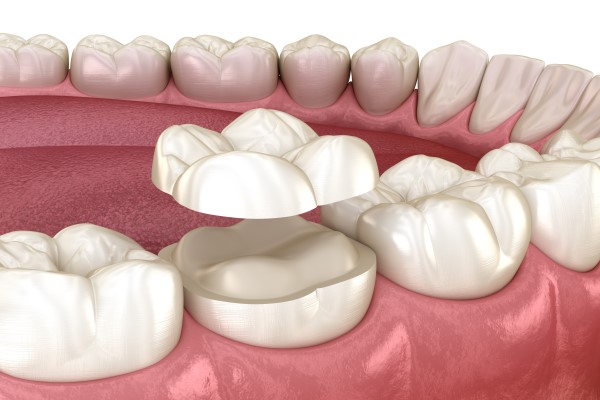When a tooth is too damaged to support a tooth filling but not damaged enough for a dental crown, you end up somewhere in the middle. Capping a damaged tooth unnecessarily with a dental crown removes more tooth structure than needed. But a large dental filling can weaken the remaining structure of the tooth, causing the tooth to break, crack or eventually need a root canal.
When you’re faced with the choice between a large tooth filling or a dental crown, do you save money now and risk major dental problems down the line or undergo possibly an unwanted dental treatment?
There is a dental restoration that can solve your problem: dental onlays. Dental onlays fall somewhere in between dental fillings and dental crowns. Like dental inlays, onlays restore large cavities without having to use a crown.
Dental Inlays v. Dental Onlays
Dental inlays and onlays are the same kind of restoration, but they cover different proportions of the tooth. A dental inlay fills the space in between the cusps, or rounded edges, at the center of the tooth’s surface. The dental onlay works like an inlay but covers one or more cusps or the entire biting surface of the tooth. Because of their extensive coverage, dental onlays are sometimes referred to as “partial crowns.”
Dental onlays are more durable and usually last longer than dental fillings but, like any restoration, can still weaken the tooth’s structure. The size of the filling and type of material you choose can help determine the life of your restoration. Depending on your budget and aesthetic needs, dental onlays can be made from gold, composite resin or porcelain.
If cared for properly, a dental onlay can last up to 30 years! Your best bet for preserving the life of any dental restoration is practicing excellent oral hygiene. Brushing, flossing and visiting the dentist regularly will have a significant outcome on the success of your dental onlay procedure.
A Direct Response to Your Dental Problem
There are two types of dental restorations: direct and indirect. Direct restorations are made in a dental office, and indirect dental restorations are made in a dental laboratory. Dental onlays are often categorized under indirect restorations, but they can be made in some dental offices as well.
The dental onlay procedure typically entails:
Indirect Onlays
During the first appointment, your dentist prepares the tooth by removing any tooth decay. Once the tooth is prepared, an impression is made of the tooth’s structure and then sent to a dental laboratory. Since it will take a few weeks to create the onlay, your dentist will place a temporary dental filling to preserve the tooth. During the second dental visit, the temporary filling is removed and the dental onlay is cemented onto the tooth.
Direct Onlays
For direct dental onlays, the same preparation is used, and the tooth is filled with composite resin material. Traditionally, the filling is molded and hardened in an oven and then cemented to the tooth. But now there’s a high-tech option for making direct dental onlays: CEREC® uses 3D computer imagery and other special equipment to produce porcelain restorations right in your dental office. By simply taking a picture of your tooth, your dentist can design and create dental onlays, dental inlays, dental crowns or veneers while you relax in the dental chair — no impressions, temporary fillings or second appointments are needed!
Reaching a Conclusion
Whether you think you need a tooth filling, dental onlay or dental crown, one thing’s for sure: Ignoring your dental problem will put you in a gray area with your dental health. Regardless of which restoration you end up with, your teeth will thank you.

